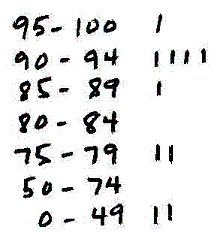- Matching:
| a. Fisher | i. First Stated the Central Limit Theorem |
| b. Cotes | ii. Tried to find the "ideal man" that
nature was trying to produce
|
| c. Tukey | iii. Was the first demographer. |
| d. de Moivre | iv. Coined the term "exploratory data
analysis." |
| e. Pascal | v. Father of modern statistics. |
| f. Gauss | vi. First described the least squares method.
|
| g. Graunt | vii. First studied the theory of errors
applied to astronomy. |
| h. Galton | viii. First applied the theory of
probability to gambling. |
| i. Quetelet | xi. Introduced the concept of correlation.
|
Ans: a. v; b. vii; c. iv; d. i; e. viii; f. iv; g. xi; h. iv.
- Why is it important for a clinical trial to be
randomized and double blind?
Ans: Randomization equalizes all the effects other than the treatment
being studied. Examples of these other effects for the Salk polio vaccine
test are socio-ecomonomic class, genetic differences, behavior patterns,
nutrition. A double blind experiment insures that the treatment is not
biased towards the vaccine due to the placebo effect: people's mental
state improves if they think they are receiving medicine, even if the
"medicine" is a placebo. A double blind experiment can also guard against bias
against the vaccine because it will prevent people from thinking that they
are immune to the disease by keeping them from going to places where they
might get infected like swimming pools.
- What is the difference between a controlled experiment and an
observational study?
Ans: A controlled experiment is randomized, whereas an observational
study is not. This means that the results of an observational study
may be confounded by other effects called lurking variables.
- Give examples of categorical, ordinal, and continuous variables.
Ans: Categorical: gender, is a smoker, race, treatment group, occupation;
examples of ordinal: year in college, response (1 to 5) on questionaire,
skill level, seat category in an airplane (coach, business class, first class);
continuous: height, weight, age, gpa, midterm score, SAT score.
- What does SPSS mean?
Ans: Statistical Package for the Social Sciences. PASW means Predictive
Analytics Software.
